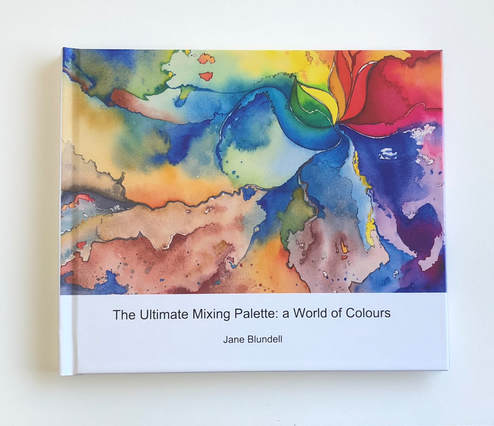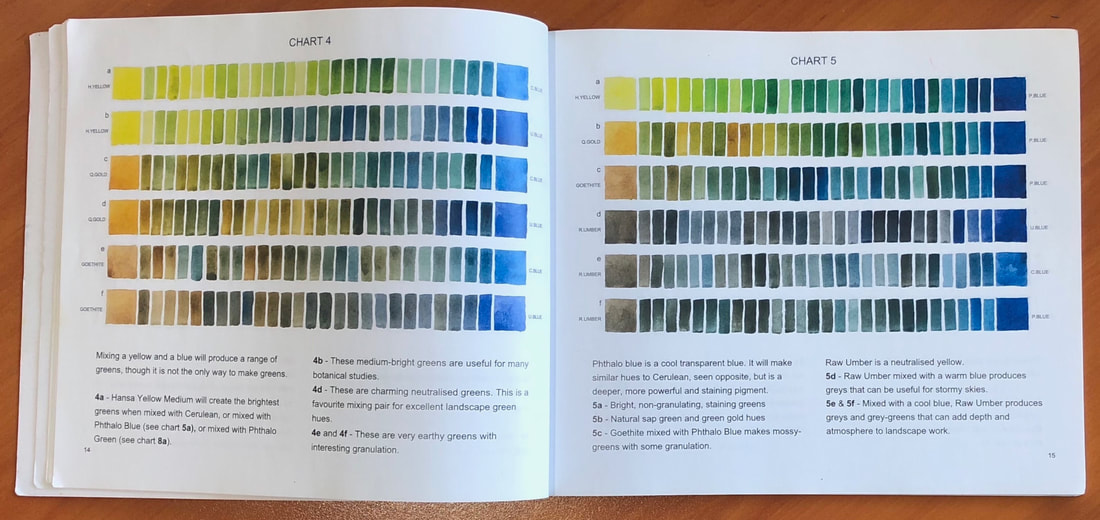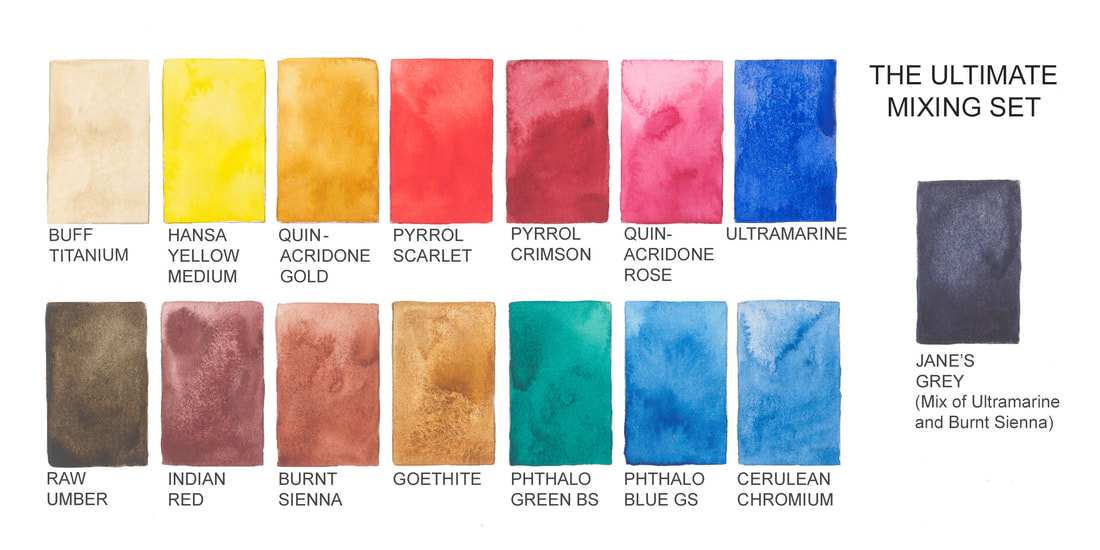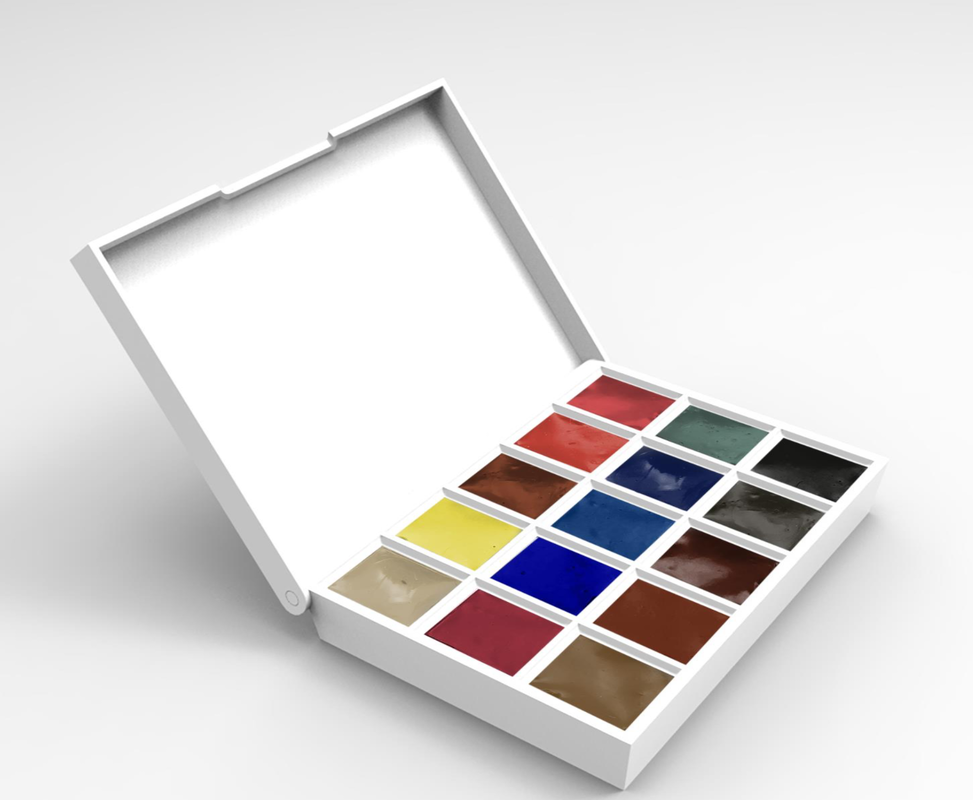The Ultimate Mixing Set - now available from Daniel Smith
I have often been asked what colours I recommend for people to buy to get started in watercolour or to upgrade to artist quality watercolours so I created this palette to address that question. It is intended as a universal palette, suitable for any subject. It is also suitable for anyone from a beginner to an experienced artist. It is rather a Goldilocks palette - not so few colours that you have to spend the whole time mixing everything together, nor so many that you lose track of what you have and how to mix them. Too many colours in a painting leads to a lack of colour harmony.
My goal was to find single pigment colours that would mix together efficiently so that most colours could be produced by mixing just two pigments. Many people find that if they mix too many pigments, they end up creating 'mud'. With this set, generally two, but at most three colours may be needed to create any hue you want. The palette colours are also useful alone. The set is painted out using Daniel Smith professional watercolours. Alternative brands are given below.
The Ultimate Mixing Palette is not intended as a limited palette but as a basic set to work with. You only need to buy 14 tubes of paint. You may wish to buy other colours for convenience, or you may choose to create you own custom-mixes of convenience colours with these original tubes by making up an orange or a purple or some greens if you work with them a lot. You should find you can make pretty much any hue you choose.
My goal was to find single pigment colours that would mix together efficiently so that most colours could be produced by mixing just two pigments. Many people find that if they mix too many pigments, they end up creating 'mud'. With this set, generally two, but at most three colours may be needed to create any hue you want. The palette colours are also useful alone. The set is painted out using Daniel Smith professional watercolours. Alternative brands are given below.
The Ultimate Mixing Palette is not intended as a limited palette but as a basic set to work with. You only need to buy 14 tubes of paint. You may wish to buy other colours for convenience, or you may choose to create you own custom-mixes of convenience colours with these original tubes by making up an orange or a purple or some greens if you work with them a lot. You should find you can make pretty much any hue you choose.
|
I am delighted that in October 2018, Daniel Smith released this set of colours in a palette with 15 half pans - including Jane's Grey.
The colours are Buff Titinium, Hansa Yellow Medium, Quinacridone Gold, Pyrrol Scarlet, Permanent Alizarin Crimson, Quinacridone Rose, Ultramarine, Cerulean Chromium, Phthalo Blue (Green Shade), Phthalo Green (Blue Shade), Goethite, Burnt Sienna, Indian Red, Raw Umber and Jane's Grey. That will make it far easier to get this set and be ready to start painting! See my blog post here for more information on the Daniel Smith new half pan sets. Click here to see my blog post about how these colours mix, as well as some of the many exploratory charts I made when creating this set. Click here for an affiliate link to Jackson's Art store in the UK - a fabulous store that ships internationally. |
Having created an ultimate mixing set, I then created a book to show how to mix the pigments to create an infinite number of colours.
The Ultimate Mixing Palette: a World of Colours
 The Ultimate Mixing Palette: a World of Colours - hard cover image wrap version. Also available in a paperback version.
The Ultimate Mixing Palette: a World of Colours - hard cover image wrap version. Also available in a paperback version.
This book is a watercolour reference book about the mixes you can create with my 'Ultimate Mixing Set' of 15 colours - 14 single pigment colours* and one convenience mixture. I recommend and use Daniel Smith watercolours for this set, which has featured on the Daniel Smith website here, though alternative colours from other brands are included below.
*the book was produced using the single pigment Quinacridone Gold, which is no longer available but has been replaced with a two pigment hue that will create very similar mixes.
You can find the eBook and all the printed versions of this book here. It is available in Premium Matt paper in hardback or softcover, or in Standard paper in softcover. The Premium paper is slightly thicker and recommended.
The eBook is available instantly and you can see a preview of the first 20 pages here.
Please make sure you set up an account with Blurb.com (or au.blurb.com etc) if you are buying the eBook or PDF from Blurb.com so you can get it again if you update your computer.
Compare prices and shipping to your country...
Australia check http://au.blurb.com/
UK check www.blurb.co.uk
Germany www.blurb.de/
US www.blurb.com
My previous book was Watercolour Mixing Charts, which you can find on Blurb.com here.)
Here are the links for each format:
- Premium Matt paper printed version - choose hard or softcover. http://www.blurb.com/b/6181312-the-ultimate-mixing-palette-a-world-of-colours
- Standard paper softecover version - http://www.blurb.com/b/6081986-the-ultimate-mixing-palette-a-world-of-colours
- eBook link for eBook http://www.blurb.com/ebooks/522172-the-ultimate-mixing-palette-a-world-of-colours suitable for iPad, iPhone and Mac computers with iBooks installed.
- PDF link http://www.blurb.com/b/6162440-the-ultimate-mixing-palette-a-world-of-colours suitable for Windows or any other digital platform. This PDF is not intended to be printed and attempting to print it would be in breach of copyright laws.
 Charts 4 and 5, from pages 14 and 15 of The Ultimate Mixing Palette: a World of Colours
Charts 4 and 5, from pages 14 and 15 of The Ultimate Mixing Palette: a World of Colours
The book contains two colour wheels and 49 colour charts. The charts show every two-colour combination (105 mixes) and 92 of the most useful three-colour mixing combinations. It includes approximately 7610 mixed hues! The charts are indexed and cross referenced, with additional notes on colour mixes, useful convenience mixes and uses for various mixes added. Every chart has been carefully hand-painted using a 1/4" flat brush onto watercolour paper, then professionally scanned with a large format camera, colour matched and cleaned up by Fine Art Imaging, ready for printing. You can see the difference that makes on my Blog post here. The charts are labelled and numbered for convenient cross-referencing.
The palette is designed to incorporate the full range of watercolour characteristics - some colours are granulating, some staining, some opaque and so on, so you can explore not just hue but characteristics as well.
There are some excellent neutralising pairs - my favourite Ultramarine + Burnt Sienna of course, but Pyrrol Crimson + Phthalo Green make a rich transparent 'Jane's Black' and Phthalo Blue + Pyrrol Scarlet make another mixed black. Buff Titanium provides a convenient light colour with wonderful granulation. It also makes it possible to create pastel tints.
Within this set there are also many wonderful primary triads. There is a cool triad of Hansa Yellow Medium, Phthalo blue and Quinacridone Rose. There is a warm triad of Pyrrol Scarlet, Ultramarine and Quinacridone Gold. There is a versatile triad of Ultramarine, Hansa Yellow Medium (or Quinacridone Gold for more neutralised greens) and Pyrrol Crimson that is very realistic to paint with, or use Quinacridone Rose for brighter purples and oranges. There is an earth triad of Cerulean Chromium, Indian Red and Goethite. There are other triads that can be explored that do not contain a red, yellow and blue but will create wonderful colour harmony in a painting, such as Quinacridone Rose with Phthalo Blue and Phthalo Green. All these and more can be found in the book.
The palette is designed to incorporate the full range of watercolour characteristics - some colours are granulating, some staining, some opaque and so on, so you can explore not just hue but characteristics as well.
There are some excellent neutralising pairs - my favourite Ultramarine + Burnt Sienna of course, but Pyrrol Crimson + Phthalo Green make a rich transparent 'Jane's Black' and Phthalo Blue + Pyrrol Scarlet make another mixed black. Buff Titanium provides a convenient light colour with wonderful granulation. It also makes it possible to create pastel tints.
Within this set there are also many wonderful primary triads. There is a cool triad of Hansa Yellow Medium, Phthalo blue and Quinacridone Rose. There is a warm triad of Pyrrol Scarlet, Ultramarine and Quinacridone Gold. There is a versatile triad of Ultramarine, Hansa Yellow Medium (or Quinacridone Gold for more neutralised greens) and Pyrrol Crimson that is very realistic to paint with, or use Quinacridone Rose for brighter purples and oranges. There is an earth triad of Cerulean Chromium, Indian Red and Goethite. There are other triads that can be explored that do not contain a red, yellow and blue but will create wonderful colour harmony in a painting, such as Quinacridone Rose with Phthalo Blue and Phthalo Green. All these and more can be found in the book.
|
Here is a detailed video showing all the colours being painted out. I'm using the little palette shown below so it will fit into the video frame :-) I have chosen to leave most of this in real time so I can explain each colour, so it is a half hour video. Make a cuppa, relax and enjoy! |
|
|
And here is the 15 colours set up in a Pocket Palette. I've used the new mini pans for phthalo blue and phthalo green since they are such powerful colours you need very little of them. The other option is to use the tiny pans for pyrrol scarlet and pyrrol crimson since these are used less often for urban and travel sketching - unless you like to paint the flowers :-) For a limited time, The Ultimate Mixing Palette will be available from Expeditionary Art, and I'll be discounting my companion printed book. |
For best mixing options, you need all 15 colours, but for those wanting just 12 colours to fit into a particular palette, Buff Titanium, Raw Umber and Jane's Grey could be removed, leaving a wonderful range of bright mixing colours, or keep Jane's Grey for convenience and remove Indian Red since it is likely to be used less and the hue can be mixed with other colours in the palette - see below. You can read more about that set of 12 in Parka's Blog here. Another alternative is to keep Buff Titanium, which I love using for beaches and sandstone, and use a single cool red Carmine by Daniel Smith (or Permanent Alizarin or Carmine from Winsor & Newton or Permanent Alizarin (Quinacridone) by Da Vinci) instead of the cool pair Pyrrol Crimson and Quinacridone Rose. Or use Pyrrol Scarlet and Quinacridone Rose as the warm and cool red and mix them together when a crimson is needed. Note though that a smaller set will be a compromise over the full 'Ultimate' mixing palette, so you'll have to do more mixing.
Here is a 12-colour version without Buff Titanium, Indian Red or Raw Umber.
Here is a 12-colour version without Buff Titanium, Indian Red or Raw Umber.
Alternative Colours
| ums_pigment_comparison.pdf | |
| File Size: | 113 kb |
| File Type: | |
While I have been painting using Daniel Smith watercolours since 1995 - almost since they were first released back in 1993 - I realise that not everyone can get hold of them and there are many other options from other companies that could be used to create very similar mixes. They may not be single pigment colours - I am only looking for similar mixing hues.
Hansa Yellow Medium PY97 (Daniel Smith) is a primary yellow, neither warm nor cool. This colour is also available as a Daniel Smith watercolour stick. Alternatives include
- Da Vinci - Arylide yellow or Da Vinci Yellow.
- Schmincke - Pure Yellow or Aureolin Hue (renamed - was Aureolin Modern).
- Winsor & Newton - Winsor Yellow.
- Maimeriblu - Primary Yellow.
- If you prefer a cool lemon yellow, Hansa Yellow Light is available in many brands - look for PY3. Another interesting very transparent option is Nickel Azo Yellow (Daniel Smith or Da Vinci) or Transparent Yellow (Winsor & Newton and Schmincke) or other brands using this transparent PY150 pigment.
Quinacridone Gold (Daniel Smith) made from PO49 was only available from Daniel Smith as they had all the pigment. The last batch was created in September 2017 and now this colour will be a hue made from PY150 and PO48. This colour is also available as a Daniel Smith watercolour stick. The hue will mix in an almost identical manner. Another similar looking alternative is Schmincke Quinacridone Gold Hue. (see above)
I find the W&N 3 pigment mixed version Quinacridone Gold too dull, and the Da Vinci version is very orange. You can mix a very close hue using W&N Transparent Yellow or Daniel Smith Nickel Azo Yellow (both PY150) mixed with a little W&N Burnt Sienna or Daniel Smith Transparent Red Oxide PR101 or Schmincke Transparent Sienna PR101 (see my Blog post about that here). These options will all mix in a very similar manner to the book.
You may prefer to use a brighter warm single pigment yellow in you palette instead of a quinacridone gold hue - such as Hansa Yellow Deep PY65 (Daniel Smith or Da Vinci), Chrome Yellow Deep (now called Chromium yellow hue deep) PY65 (Schmincke) or any yellows made with PY153. Just keep in mind you will need to add a touch of Burnt Sienna to these yellows to mix the same as the Quinacridone Gold in the book.
Pyrrol Scarlet PR255 (Daniel Smith) is a lovely warm red. This colour is not available as a Daniel Smith watercolour stick, but Organic Vermilion is similar in mixing. Alternative warm reds are many but the closest match will also use PR255
- Schmincke - Vermilion PR255
- Da Vinci - Permanent Red
- Or use Organic Vermilion (Daniel Smith) though these will not mix exactly the same. I generally suggest that it is better to keep cadmiums for special purposes where their greater opacity is required, and use transparent yellows, oranges and reds in a general palette.
Pyrrol Crimson PR264 (Daniel Smith) is a rich crimson with good light-fastness. This colour is not available as a Daniel Smith watercolour stick but Permanent Alizarin Crimson is almost identical in hue so will mix the same way - that is what has been included in the new Daniel Smith 15 pan Ultimate Mixing Set. Alternatives include -
- Schmincke - Ruby Red Deep PR264
- Winsor & Newton - Winsor Red Deep PR264
- Permanent Alizarin Crimson in many brands, including Daniel Smith,
- Anthraquinoid Red PR177 Daniel Smith and others.
- Make sure it is a powerful crimson rather than a rose red. Avoid Alizarin Crimson made with PR83 as it will fade.
Quinacridone Rose PV19 (Daniel Smith) is a beautiful bright rose red. It is a very pure mixing colour and makes gorgeous purples. This colour is not available as a Daniel Smith watercolour stick but Quinacridone Red will be very similar and the same pigment. Alternatives are
- Da Vinci - Permanent Rose PV19
- Schmincke - Ruby Red PV19
- Winsor & Newton - Permanent Rose PV19
- MaimeriBlu - Primary Red magenta and many others with PV19.
- Quinacridone Magenta PR122 or Schmincke Purple Magenta PR122 or Quinacridone Lilac (Daniel Smith) could be used instead though the mixes would not look exactly the same. I find the rose colour more useful in its pure state than a magenta colour.
Ultramarine (Daniel Smith) is a beautiful granulating warm blue. Most brands make an ultramarine using PB29. They may vary and be more or less granulating or slightly warmer or slightly cooler but all should be suitable. This colour is also available as a Daniel Smith watercolour stick. Daniel Smith also make a French Ultramarine, but I prefer the series 1 Ultramarine as it makes my Jane's Grey colour.
- Da Vinci Ultramarine is a great choice if you want really large tubes as it is available in 37ml tubes.
- Schmincke have introduced a granulating French Ultramarine and also have a very finely ground Ultramarine Finest for those who don't want as much granulation.
Cerulean Blue Chromium PB36 (Daniel Smith) - There are two pigments used for Cerulean - PB35 and PB36. I prefer PB36 - the Chromium version - as it is cooler and richer. This colour is also available as a Daniel Smith watercolour stick.
- Schmincke - Cobalt Cerulean PB36,
- Da Vinci - Cerulean Genuine PB36
- Old Holland - Cerulean Deep PB35
Phthalo Blue (Green Shade) PB15:3 (Daniel Smith) - called many other names by different manufacturers, but made with PB15 or PB15:3. This colour is also available as a Daniel Smith watercolour stick.
- Da Vinci - Phthalo Blue
- Winsor & Newton - Winsor Blue Green Shade
- Schmincke - Helio Cerulean Blue
Phthalo Green (Blue Shade) (Daniel Smith) - this is a powerful staining transparent mixing green made with PG7. This colour is also available as a Daniel Smith watercolour stick.
- Da Vinci - Phthalo Green
- Winsor & Newton - Winsor Green blue shade,
- MaimerBlu - Cubric Green deep
- Schmincke - Phthalo Green
Goethite PY43 (Daniel Smith) - this is a Daniel Smith exclusive and I love it for the granulation - it is wonderful for beach and landscape scenes, sandstone and rocks generally. It is also useful for skin tones, but a raw sienna is another option. Just make sure it isn't the same hue as the Quinacridone Gold so avoid Winsor & Newton for this one if you are using DS Quin Gold - they would look too similar.
- Yellow Ochre is another yellow earth option, as is
- Daniel Smith Mont Amiata Natural Sienna.
- (This colour is not available as a Daniel Smith watercolour stick so I'd suggest Yellow Ochre instead.)
Burnt Sienna PBr7 (Daniel Smith) - this colour varies hugely by manufacturer. I like the earthy brown PBr7 versions of the Daniel Smith and Da Vinci and the beautiful new Schmincke Maroon Brown, but some like the more burnt orange look of Winsor & Newton Burnt Sienna and Schmincke's new Transparent Sienna made with PR101. The Daniel Smith Transparent Red Oxide, also PR101, is another option here. Aim for a single pigment if you can, preferably PBr7 as then it is a useful colour straight from the palette as an earthy warm orange-brown and skin tone colour. (This colour is also available as a Daniel Smith watercolour stick)
Indian Red (Daniel Smith) - PR101 is used in a range of colours including the completely different burnt orange W&N Burnt Sienna colour, but what I like about this pigment is that it is very opaque, granulating and can be a little wild. It is a red earth colour so makes a wonderful triad with Goethite and Cerulean chromium. Da Vinci make an Indian Red, so does W&N and many others. If the paint is called Indian red and made with PR101 it should be similar in characteristics. Venetian red is different but could be used in the red-earth spot if that's what you have. (This colour is not available as a Daniel Smith watercolour stick so I'd use Piemontite instead.)
Raw Umber PBr7 (Daniel Smith) - This should be a deep cool brown but the W&N version is weak and light and not recommended. Da Vinci and M.Graham are the best alternatives I have found to this lovely Daniel Smith colour. It is great for shadow areas on a figure or in a landscape. Not perhaps essential but incredibly useful as it takes a little more effort to mix this colour. Schmincke have added a 'green umber' to their revamped range in 2017 which is a cool brown made with PBr7, but it is not as strong as the DS, DV or MG versions. (This colour is not available as a Daniel Smith watercolour stick, which is a shame.)
Jane's Grey PBr7+PB29 - I make this with Daniel Smith Ultramarine and Burnt Sienna, and was released as a new DS tube 'Signature Series' colour in February 2019. Alternatives are Daniel Smith Sodalite Genuine or create a grey with your own ultramarine and burnt sienna options. I like it to be almost completely neutral, with just a hint more of the blue than the brown. If using Da Vinci watercolours, go with French Ultramarine and burnt sienna to get the closest hue. In Schmincke, you can use the Neutral Grey - it isn't the same pigment mix, but it is made without any black pigments, which is very unusual for convenience greys, or mix French Ultramarine and Maroon Brown. (This colour is not available as a Daniel Smith watercolour stick, but Sodilite Genuine could be substituted.)
Buff Titanium PW6:1 (Daniel Smith) - this is a Daniel Smith colour that I believe only Aquarius and QoR have included in their range, though the QoR version doesn't have the granulation of this one that I love. If you can't get the single pigment version I'd skip this altogether. (This colour is also available as a Daniel Smith watercolour stick)
You can see all these colours and compare them in the 'Painted Watercolour Swatches' tab. Click here for the article I wrote on this palette and book for the Daniel Smith website and Blog in May 2015. It lists a number of Daniel Smith alternate colours.
I am very excited about this book as it is tremendously helpful as a reference guide to colour mixing for any watercolour artist from beginner to expert. It was published on Blurb.com as an eBook and a physical book in soft and hard cover versions in March 2015. Here is a link to all versions of both of my watercolour mixing books. More in progress, including the next will be 'Working with Triads' :-)
This page was last updated September 2019 © Jane Blundell






